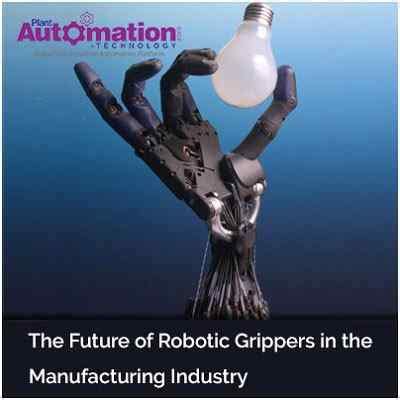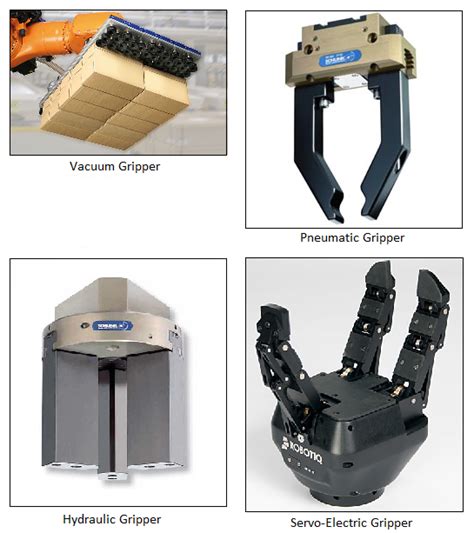The Future of Automation: Industrial Gripper Robots
Introduction
Industrial gripper robots are rapidly transforming the manufacturing industry, automating repetitive and potentially hazardous tasks, increasing productivity, and enhancing the overall efficiency of production lines. This article explores the advancements, applications, and benefits of industrial gripper robots, providing a comprehensive overview of their role in shaping the future of automation.
Types of Industrial Gripper Robots
Industrial gripper robots come in various configurations, each designed to handle specific tasks and materials. Common types include:

-
Parallel Grippers: With parallel jaws that move in unison, these grippers are suitable for handling flat objects like sheets and panels.
-
Scissor Grippers: Featuring crossing blades that form a scissor-like action, these grippers excel in gripping irregularly shaped objects.
-
Vacuum Grippers: Utilizing suction cups, vacuum grippers handle delicate objects or those with porous surfaces.
-
Magnetic Grippers: Employing magnetic force, these grippers are ideal for handling ferrous metal objects.
Applications of Industrial Gripper Robots
Industrial gripper robots find applications in a wide range of manufacturing industries, including:
-
Automotive: Assembly, welding, and part handling
-
Electronics: Component placement, soldering, and inspection
-
Food and Beverage: Packaging, palletizing, and inspection
-
Pharmaceuticals: Dispensing, packaging, and testing
-
Warehousing and Logistics: Picking, sorting, and loading
Benefits of Industrial Gripper Robots
The adoption of industrial gripper robots offers numerous advantages:

-
Increased Productivity: Automating tasks increases production rates and reduces labor costs.
-
Improved Safety: Robots eliminate the risk of human injury from hazardous tasks.
-
Enhanced Accuracy: Robots perform tasks with precision and repeatability, minimizing errors.
-
Reduced Downtime: Robots operate 24/7, increasing uptime and reducing downtime for maintenance.
-
Improved Flexibility: Robots can be easily reprogrammed to perform different tasks, adapting to changing production needs.
Integration of Industrial Gripper Robots
Integrating industrial gripper robots into existing manufacturing systems requires careful planning and execution. Key considerations include:
-
Payload Capacity: Determine the weight and size of objects the robot will handle.
-
Reach and Workspace: Assess the required reach and workspace area of the robot.
-
Control System: Choose a control system that integrates seamlessly with existing infrastructure.
-
Safety Features: Implement safety measures such as emergency stop buttons and light curtains.
-
Maintenance and Support: Establish a maintenance and support plan to ensure optimal robot performance.
Advancements in Industrial Gripper Robots
The field of industrial gripper robots is witnessing continuous advancements:
-
Collaborative Robots: Robots designed to work safely alongside humans, increasing flexibility and productivity.
-
Intelligent Grippers: Grippers equipped with sensors and algorithms that enable them to adapt to object variations.
-
Cybersecurity: Enhanced security measures to protect robots from cyber threats.
-
AI and Machine Learning: Integration of AI and machine learning algorithms for advanced object recognition and manipulation.
Case Studies of Industrial Gripper Robot Success
-
Automotive: A leading automotive manufacturer reported a 25% increase in welding production after implementing industrial gripper robots.
-
Electronics: An electronics company reduced component placement time by 30% using vacuum gripper robots.
-
Pharmaceuticals: A pharmaceutical company automated dispensing and packaging processes with industrial gripper robots, resulting in a 15% reduction in production costs.
Tips and Tricks for Using Industrial Gripper Robots
- Calibrate the robot regularly to ensure accuracy.
- Use the correct gripper type for the specific application.
- Optimize robot programming for efficiency and cycle time.
- Regularly inspect and maintain the robot to prevent downtime.
- Train operators thoroughly on robot operation and safety procedures.
Common Mistakes to Avoid
- Overloading the robot beyond its capacity.
- Using the wrong gripper type for the application.
- Neglecting regular maintenance and inspection.
- Failing to train operators adequately on robot use.
- Ignoring cybersecurity measures.
How to Select the Right Industrial Gripper Robot
Selecting the optimal industrial gripper robot requires considering:

-
Task Requirements: Determine the specific tasks the robot will perform.
-
Payload and Reach: Assess the weight and size of objects and the required reach.
-
Integration: Evaluate how the robot will integrate with existing systems.
-
Features and Capabilities: Identify the necessary features and advanced capabilities.
-
Budget and Return on Investment: Consider the cost and potential ROI of robot implementation.
Step-by-Step Approach to Industrial Gripper Robot Implementation
-
Assessment and Planning: Define the project scope, objectives, and requirements.
-
Selection and Procurement: Choose the appropriate robot and gripper combination.
-
Integration and Setup: Install and configure the robot and integrate it with existing systems.
-
Programming and Optimization: Develop and optimize robot programs for specific tasks.
-
Training and Deployment: Train operators and deploy the robot into production.
-
Maintenance and Support: Establish a maintenance and support plan to ensure continuous operation.
Advanced Features of Industrial Gripper Robots
-
Force Sensing: Grippers with force sensors enable precise object manipulation and collision avoidance.
-
Camera Integration: Robots equipped with cameras for object recognition and inspection.
-
Tool Changing: Robots capable of changing tools, such as grippers, to handle different objects.
-
Motion Control: Advanced motion control algorithms for optimal robot performance and energy efficiency.
FAQs about Industrial Gripper Robots
- What is the cost of an industrial gripper robot?
- Costs vary depending on size, payload, and features, but typically range from $10,000 to $100,000.
- How long does it take to implement an industrial gripper robot?
- Implementation time varies based on complexity, but typically takes a few weeks to several months.
- What is the ROI of an industrial gripper robot?
- ROI can be substantial, with reported increases in productivity, reduced labor costs, and improved safety.
Call to Action
As the demand for automation in manufacturing continues to grow, industrial gripper robots are poised to play a pivotal role in shaping the future of production lines. By embracing the benefits and advancements of these robots, manufacturers can enhance their productivity, safety, and efficiency, driving innovation and competitiveness in the global market.
Tables
Table 1: Types of Industrial Gripper Robots
| Type of Gripper |
Description |
Applications |
| Parallel |
Parallel jaws that move in unison |
Handling flat objects |
| Scissor |
Crossing blades that form a scissor-like action |
Gripping irregularly shaped objects |
| Vacuum |
Utilizes suction cups |
Handling delicate or porous objects |
| Magnetic |
Employs magnetic force |
Handling ferrous metal objects |
Table 2: Benefits of Industrial Gripper Robots
| Benefit |
Description |
Impact |
| Increased Productivity |
Automates tasks, increasing production rates |
Reduced labor costs |
| Improved Safety |
Eliminates risk of human injury |
Enhanced workplace safety |
| Enhanced Accuracy |
Performs tasks with precision and repeatability |
Reduced errors |
| Reduced Downtime |
Operates 24/7 |
Increased uptime |
| Improved Flexibility |
Easily reprogrammed for different tasks |
Adaptability to changing production needs |
Table 3: Factors to Consider When Selecting an Industrial Gripper Robot
| Factor |
Description |
Importance |
| Task Requirements |
Specific tasks the robot will perform |
Determines robot capabilities |
| Payload and Reach |
Weight and size of objects, required reach |
Ensures robot suitability |
| Integration |
Integrating with existing systems |
Smooth implementation and compatibility |
| Features and Capabilities |
Necessary features and advanced capabilities |
Optimizes robot performance |
| Budget and ROI |
Cost and potential return on investment |
Justifies robot implementation |

